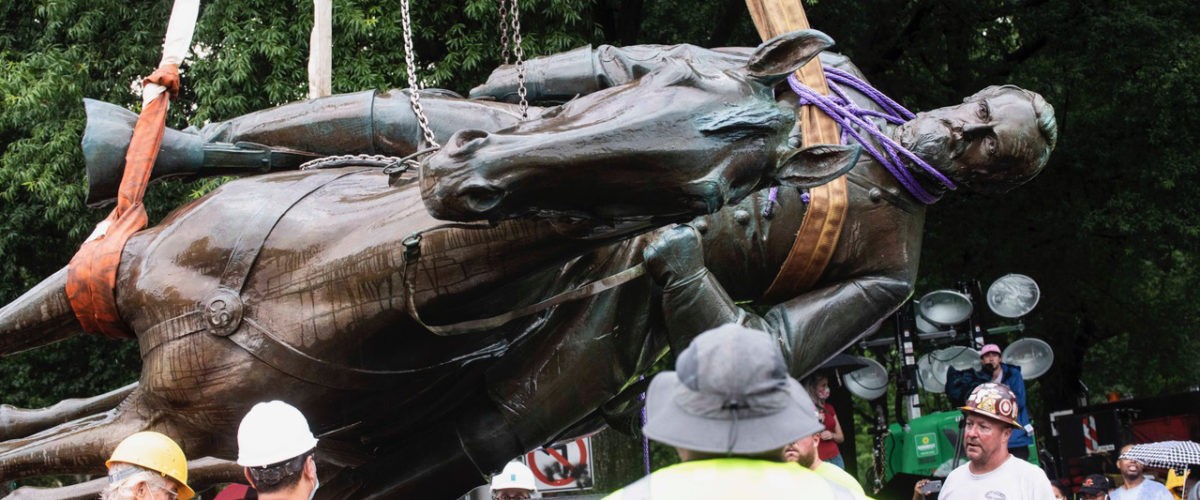Statues are a funny thing. They say so much about people — their beliefs, their politics, their worldview.
I grew up around all kinds of statues. In the home of my birth (and the city I lived in until I boarded a plane for college) were statues — everywhere. The grand avenues we drove on oftentimes intersected monuments, mostly ideological and political. The monuments and avenues were very similar to my current hometown. You traversed the city on primary avenues and hoped to skirt around the monuments at the inevitable roundabout as quickly as possible.
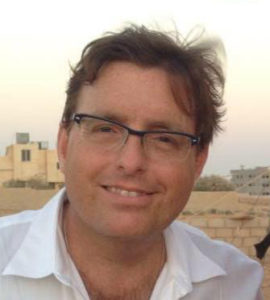
Craig Martin
The difference in the city of my youth, Bangkok, Thailand, versus the city of my adult life, Richmond, Va., was that the roundabout at the Victory Monument in Bangkok usually required a minimum of 45 minutes to successfully traverse in the log-jammed traffic. I was not fond of those statues.
Growing up as a Southern Baptist missionary kid in Bangkok, those political statues didn’t offer much except hours of sitting in traffic, oftentimes on buses without air conditioning in the tropical heat. The statues that fascinated me, as they did most foreigners, were the statues of Buddha.
We had the reclining buddha in Wat (temple) Po, shiny and gold, spanning 50 yards with giant feet engraved with mother of pearl inlay. The most famous site in Thailand is Wat Phra Kaew, the royal palace property that includes the “temple of the emerald buddha.” The emerald buddha is a jasper (not emerald) statue atop a massive gold pedestal. The buddha’s wardrobe is changed each season with ornamental robes significant to the seasons.
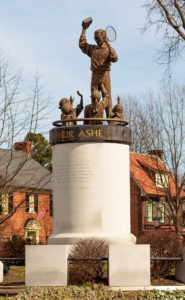
Arthur Ashe statue in Richmond (Shutterstock)
When I moved to Richmond in the mid-1990s to work for the Southern Baptist Foreign Mission Board, I lived in a part of the city called the Lower Fan. Each day I made my way down Monument Avenue past the statues of J.E.B Stuart, Robert E. Lee, Stonewall Jackson, Matthew Fontaine Maury and culminating at the last statued intersection with a tribute to Arthur Ashe just two blocks away from 3806 Monument Avenue.
3806 Monument Avenue is the tony street address of a nondescript brick building housing the Foreign Mission Board’s (now IMB) headquarters. On my commute, I would pass First Baptist Church at the intersection of the Boulevard and Monument Avenue famous for its towering statue of Stonewall Jackson proudly mounted on his famous steed “Little Sorrel.”
White churches of all shapes and denominations dot the centerpiece avenue of Richmond. Black churches are located in poorer parts of the city. Not long after I first moved to Richmond in the mid-1990s, the Arthur Ashe Monument was erected. My colleagues and I walked the two blocks down to the intersection to watch protesters for and against the modern statue.
Now, all these many years later from my house in Carytown, I can walk five blocks from my house to Arthur Ashe Boulevard, renamed a year ago from the Boulevard (an almost foreboding event of things to come). That ceremony included Georgia Congressman John Lewis. Nowadays, a tribute to his life is projected at night on the side of the Robert E. Lee Monument.

Kehinde Wiley statue, “Rumors of War” at Virginia Museum of Fine Arts
Once at Arthur Ashe Boulevard, I can take a left by the Virginia Museum of Fine Arts past the Kehinde Wiley statement statue, “Rumors of War” with the Daughters of the Confederacy across the grass in the shadows of this incredible work of art. Once George Floyd was brutally killed and the protests began, Kehinde’s statue was untouched and the UDC building was tagged up and torched.
Seemingly overnight these monuments and avenues were changed. A past of racism and social injustice was suddenly turned upside down, and as I write there are only two statues remaining on the illustrious Monument Avenue.
On one end is Arthur Ashe, the first Black player selected to the United States Davis Cup Team. Ashe was the only Black man ever to win the singles title at the U.S. Open, Wimbledon and the Australian Open. He stood up against the apartheid government of South Africa and will be remembered for his accomplishments in tennis and his fight for racial justice.
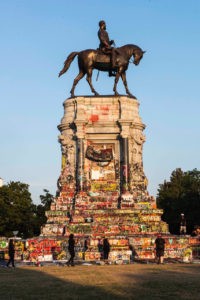
Robert E. Lee statue in Richmond, now covered in graffiti. (Photo by Warren F. Johnson)
On the other end of Monument Avenue is the gigantic Robert E. Lee statue. While it is the only Confederate statue to remain (the others have been unceremoniously removed), it looks a lot different now. It is covered in colorful graffiti, some profane. It also is covered now in beautiful works of art.
While there are some who would say that by removing these Confederate statues Richmond is “erasing history,” most of us who live in the city are saying good riddance. Incidentally, many of the citizens making the “erasing of history” argument are the same people who cheered on as Iraqis toppled massive statues of Saddam Hussein during the second Gulf War. The difference between Lee and Hussein was that Lee was in power for four years while Hussein controlled with an iron fist for three decades. I guess history “over there” doesn’t matter much.
I look back through the quarter-century I have lived in this city and reflect on that famous and infamous avenue (depending on the color of your skin) and think about the ideological and theological battles waged during that time. While people of color were begging for true racial justice and equality, our denominations were debating issues related to power and property.
Yes, some of those battles were important for the future, but they were largely about the past. So, while we debated the details of the Bible, the generation after us was begging for us to do something about serious issues like poverty in our city, the gap in wages between people of color and white people and outright blatant racism disguised as “state’s rights” and Confederate “heritage.”
Well guess what, that generation now is distrustful of all institutions — including church. And they are taking matters into their own hands.
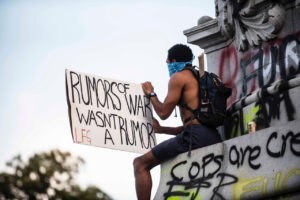 I watched as protesters of every color, gender and sexual orientation marched together while others spray-painted over the memories of traitors to our nation. Many times, peaceful protests were met with tear gas and militant aggression. At times, opportunists damaged property and caused ugly destruction.
I watched as protesters of every color, gender and sexual orientation marched together while others spray-painted over the memories of traitors to our nation. Many times, peaceful protests were met with tear gas and militant aggression. At times, opportunists damaged property and caused ugly destruction.
But I spoke with an old Black pastor who works out of a church in view of the Lee Monument — a church that provides programs to the poor youth of our city. He said he didn’t like the looting and the destruction of property but sometimes the only way white America listens is when it affects their pocketbooks.
Mind you, he was not a radical activist by any means. He is a Richmond native who has heard a lot of talk and seen no action during his lifetime. Instead of being a bridge in the debate, the white churches publicly didn’t say much. Or, worse yet, congregants privately were divisive and unwelcoming to even the hint that the statues on Monument Avenue should come down for the unjust history of slavery they represent.
So here we are at this new uncertain intersection of history, politics and change.
I recently met an incredibly smart and gifted leader here in Richmond named Dontrese Brown. We talked a good while (masked and socially distanced) in his office. Before I left Dontrese, he asked if we could take some photos for social media. I noticed some other folks from previous photos with various statements Dontrese had printed on T-shirts in the office. One in particular stood out to me. I raved about it to the point that he walked over to a pile of shirts and dug out an XXL. I wore it the other night at an event and proudly displayed it with its word, “Racism is Not a Debate.”
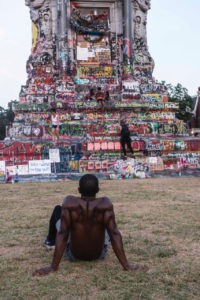
After the crowds had left, a man reflects on the remnant of the Robert E. Lee statue in Richmond. (Photo by Warren F. Johnson)
I’m not sure what will happen in the future to all of the historic monuments on all the historic avenues around the world. I won’t even pretend to prescribe what should or shouldn’t happen to many of them. Some of them represent ideologies of oppression, war, racism and political opportunism. But there are also shiny religious statues and statues to famous athletes and celebrity musicians and writers.
All I know is that in my hometown of Richmond, the centerpiece statues representing the struggle for slavery will soon all be gone. A new generation had to take matters into its own hands. That generation removed and is replacing those historic monuments with new ones on those historic avenues. Things are different now. As on my statement T-shirt, this new generation gets that racism is not a debate.
Craig Martin is author of the new book </i>Confessions of a Philanthropologist<i> and co-host and producer of the PBS series The Good Road.


